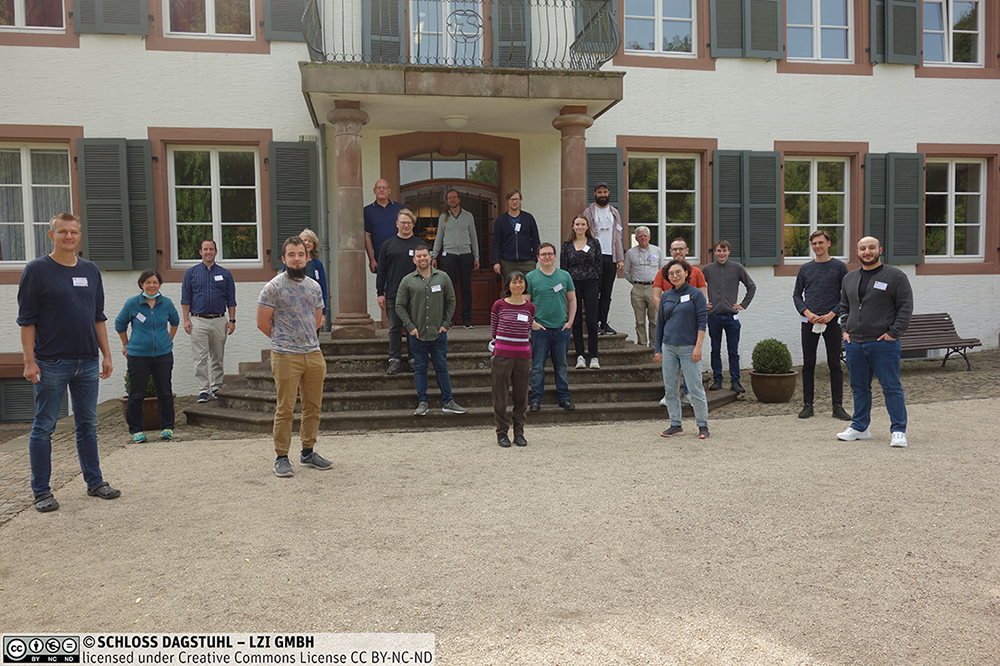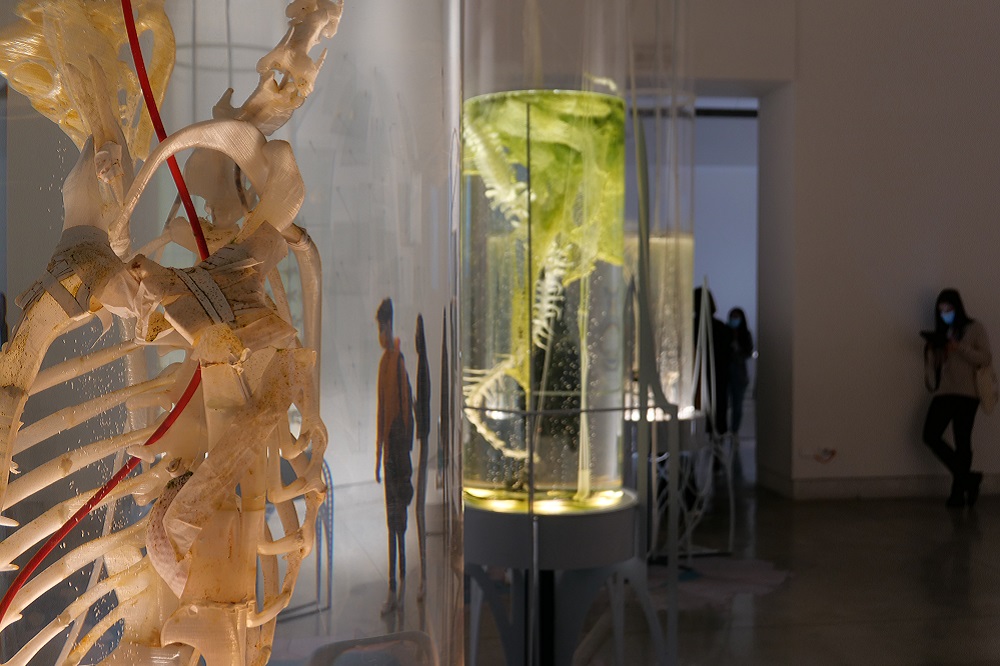Jasmine Lu and Pedro Lopes of the University of Chicago published a paper in late 2022 describing the integration of an organism – the single-celled slime mold Physarum Polycephalum – into a wearable. From the abstract: “Researchers have been exploring how incorporating care-based interactions can change the user’s attitude & relationship towards an interactive device. This is typically achieved through virtual care where users care for digital entities. In this paper, we explore this concept further by investigating how physical care for a living organism, embedded as a functional component of an interactive device, also changes user-device relationships. Living organisms differ as they require an environment conducive to life, which in our concept, the user is responsible for providing by caring for the organism (e.g., feeding it). We instantiated our concept by engineering a smartwatch that includes a slime mold that physically conducts power to a heart rate sensor inside the device, acting as a living wire. In this smartwatch, the availability of heart-rate sensing depends on the health of the slime mold – with the user’s care, the slime mold becomes conductive and enables the sensor; conversely, without care, the slime mold dries and disables the sensor (resuming care resuscitates the slime mold).” (Lu and Lopes 2022) The paper “Integrating Living Organisms in Devices to Implement Care-based Interactions” can be downloaded here.
Proceedings of Robophilosophy 2022
In January 2023, the proceedings of Robophilosophy 2022 were published, under the title “Social Robots in Social Institutions”. “This book presents the Proceedings of Robophilosophy 2022, the 5th event in the biennial Robophilosophy conference series, held in Helsinki, Finland, from 16 to 19 August 2022. The theme of this edition of the conference was Social Robots in Social Institutions, and it featured international multidisciplinary research from the humanities, social sciences, Human-Robot Interaction, and social robotics. The 63 papers, 41 workshop papers and 5 posters included in this book are divided into 4 sections: plenaries, sessions, workshops and posters, with the 41 papers in the ‘Sessions’ section grouped into 13 subdivisions including elderly care, healthcare, law, education and art, as well as ethics and religion. These papers explore the anticipated conceptual and practical changes which will come about in the course of introducing social robotics into public and private institutions, such as public services, legal systems, social and healthcare services, or educational institutions.” (Website IOS Press) The proceedings contain the paper “Robots in Policing” by Oliver Bendel and the poster “Tamagotchi on our couch: Are social robots perceived as pets?” by Katharina Kühne, Melinda A. Jeglinski-Mende, and Oliver Bendel. More information via www.iospress.com/catalog/books/social-robots-in-social-institutions.
Minding Animals 2024
After an hiatus of six years, Minding Animals will return, with a conference tentatively scheduled to be held 11 – 17 July, 2024. This was announced by the organizers in a message dated December 19, 2022. “Just like the postponed 2021 conference, Minding Animals 5 (MAC5) will be hosted by the Centre for Compassionate Conservation (CfCC) in the Transdisciplinary School at the University of Technology, Sydney (UTS).” (Message from Minding Animals International) The organizers refer to the Minding Animals Bulletin 53 regarding the vision of the conference and the preparation of the authors. “We believe that the greatest threat posed to the planet, to all planetary life, human or nonhuman animal, plant or otherwise, including the current pandemic, is the intersection of animal agriculture and the climate crisis. Hence, the urgency and criticality of climate as the key theme.” (Minding Animals Bulletin 53) Possible subtopics include “The biodiversity crisis and climate change”, “Rewilding and compassionate conservation”, “The animal industrial complex”, “Animals, the circular economy and sustainable food systems”, and “Animals in development and food sovereignty”.
Programming Machine Ethics
The book “Programming Machine Ethics” (2016) by Luís Moniz Pereira and Ari Saptawijaya is available for free download from Z-Library. Luís Moniz Pereira is among the best-known machine ethicists. “This book addresses the fundamentals of machine ethics. It discusses abilities required for ethical machine reasoning and the programming features that enable them. It connects ethics, psychological ethical processes, and machine implemented procedures. From a technical point of view, the book uses logic programming and evolutionary game theory to model and link the individual and collective moral realms. It also reports on the results of experiments performed using several model implementations. Opening specific and promising inroads into the terra incognita of machine ethics, the authors define here new tools and describe a variety of program-tested moral applications and implemented systems. In addition, they provide alternative readings paths, allowing readers to best focus on their specific interests and to explore the concepts at different levels of detail.” (Information by Springer) The download link is eu1lib.vip/book/2677910/9fd009.
Plastic Waste in the Pacific Comes from the Fishing Industry
The Ocean Cleanup project has analyzed the plastic waste it has fished out of the sea. The results were published in a paper. From the abstract: “The subtropical oceanic gyre in the North Pacific Ocean is currently covered with tens of thousands of tonnes of floating plastic debris, dispersed over millions of square kilometres. A large fraction is composed of fishing nets and ropes while the rest is mostly composed of hard plastic objects and fragments, sometimes carrying evidence on their origin. In 2019, an oceanographic mission conducted in the area, retrieved over 6000 hard plastic debris items > 5 cm. The debris was later sorted, counted, weighed, and analysed for evidence of origin and age. Our results, complemented with numerical model simulations and findings from a previous oceanographic mission, revealed that a majority of the floating material stems from fishing activities. While recent assessments for plastic inputs into the ocean point to coastal developing economies and rivers as major contributors into oceanic plastic pollution, here we show that most floating plastics in the North Pacific subtropical gyre can be traced back to five industrialised fishing nations, highlighting the important role the fishing industry plays in the solution to this global issue.” (Abstract) In a final thesis at the University of Applied Sciences and Arts Northwestern Switzerland FHNW in 2019, a student described and evaluated six projects for the disposal of plastic waste in seas. An overview can be found here. The Ocean Cleanup was also discussed, beside the WasteShark that sticks out as a robot.
Hold a Video Call Naked Without Trouble
A software developer has created a tool that retouches pants on lower body to protect from embarrassing situations. He presents his solution in his video channel Everything Is Hacked on YouTube, under the title “I made a Zoom filter to add pants when you forget to wear them”. Under the video the software developer writes: “Using Python, OpenCV, MediaPipe, and pyvirtualcam to create a Zoom (or Teams or Hangouts or whatever) video filter to blur out your lower half or add customizable pants. This should work on any platform + video call app, as well as on recordings.” (Everything Is Hacked, May 10, 2022) You can watch the video here. The code is available at https://github.com/everythingishacked/Pants …
Extended Deadline for the Robophilosophy 2022 Conference
Robophilosophy 2022 is the fifth event in the biennial Robophilosophy Conference Series. The first call for papers (CfP) was published in November 2021, the second at the end of 2021, and the final on February 25, 2022. The extended deadline for submissions of extended abstracts and full papers is March 10, 2022. The event “will explore the societal significance of social robots for the future of social institutions with its usual broad scope, embracing both theoretical and practical angles” (CfP Robophilosophy). It “is an invitation to philosophers and other SSH researchers, as well as researchers in social robotics and HRI, to investigate from interdisciplinarily informed perspectives whether and how social robotics as an interdisciplinary endeavour can contribute to the ability of our institutions to perform their functions in society” (CfP Robophilosophy). Topics of interest are robots and social institutions in general, robots in law and policing, robots in healthcare, and robots and social justice, amongst others. The conference will be held at the University of Helsinki in Finland from August 16-19, 2022. More information via www.rp2022.org.
Dagstuhl Report on Trustworthy Autonomous Systems
On February 18, 2022, the Dagstuhl Report “Conversational Agent as Trustworthy Autonomous System (Trust-CA)” was published. Editors are Effie Lai-Chong Law, Asbjørn Følstad, Jonathan Grudin, and Björn Schuller. From the abstract: “This report documents the program and the outcomes of Dagstuhl Seminar 21381 ‘Conversational Agent as Trustworthy Autonomous System (Trust-CA)’. First, we present the abstracts of the talks delivered by the Seminar’s attendees. Then we report on the origin and process of our six breakout (working) groups. For each group, we describe its contributors, goals and key questions, key insights, and future research. The themes of the groups were derived from a pre-Seminar survey, which also led to a list of suggested readings for the topic of trust in conversational agents. The list is included in this report for references.” (Abstract Dagstuhl Report) The seminar, attended by scientists and experts from around the world, was held at Schloss Dagstuhl from September 19-24, 2022. The report can be downloaded via drops.dagstuhl.de/opus/volltexte/2022/15770/.
Human and Animal Enhancement in the Context of Architecture
The 17th International Architecture Exhibition – the entire series, including the art section, is known as La Biennale di Venezia – ran from 22 May to 21 November 2021, with the Salon Suisse curated by architect and publicist Evelyn Steiner. On 18 November 2021, the event “Jethro Knights, Armor Guyver, and Mutant X: How transhumanists challenge architecture” took place. Prof. Dr. Oliver Bendel gave a talk on “Human and animal enhancement in the context of architecture”, followed by a discussion with Mike Schaffner (a Swiss cyborg) and Prof. Dr. Georg Vrachliotis (an architect at TU Delft). First, the information and machine ethicist clarified key terms such as “human enhancement”, “animal enhancement”, “biohacking”, “bodyhacking”, “cyborg”, and “transhumanism”. He also brought in his own terms “robot enhancement” and “reversed cyborg” or “inverted cyborg”. He then presented examples of human enhancement and animal enhancement, including in the context of architecture: cats with chips getting into the house, humans with chips bringing the smart home to adaptations, animals and humans with chips and transmitters detected in time in traffic, and enhanced and improved organisms that can live on alien planets. He concluded by offering ethical considerations. He was open to the idea of cyborgs and critical of the transhumanism movement. The booklet on Salon Suisse is available here.
When Robots Flatter the Customer
Under the supervision of Prof. Dr. Oliver Bendel, Liliana Margarida Dos Santos Alves wrote her master thesis “Manipulation by humanoid consulting and sales hardware robots from an ethical perspective” at the School of Business FHNW. The background was that social robots and service robots like Pepper and Paul have been doing their job in retail for years. In principle, they can use the same sales techniques – including those of a manipulative nature – as salespeople. The young scientist submitted her comprehensive study in June 2021. According to the abstract, the main research question (RQ) is “to determine whether it is ethical to intentionally program humanoid consulting and sales hardware robots with manipulation techniques to influence the customer’s purchase decision in retail stores” (Alves 2021). To answer this central question, five sub-questions (SQ) were defined and answered based on an extensive literature review and a survey conducted with potential customers of all ages: “SQ1: How can humanoid consulting and selling robots manipulate customers in the retail store? SQ2: Have ethical guidelines and policies, to which developers and users must adhere, been established already to prevent the manipulation of customers’ purchasing decisions by humanoid robots in the retail sector? SQ3: Have ethical guidelines and policies already been established regarding who must perform the final inspection of the humanoid robot before it is put into operation? SQ4: How do potential retail customers react, think and feel when being confronted with a manipulative humanoid consultant and sales robot in a retail store? SQ5: Do potential customers accept a manipulative and humanoid consultant and sales robot in the retail store?” (Alves 2021) To be able to answer the main research question (RQ), the sub-questions SQ1 – SQ5 were worked through step by step. In the end, the author comes to the conclusion “that it is neither ethical for software developers to program robots with manipulative content nor is it ethical for companies to actively use these kinds of robots in retail stores to systematically and extensively manipulate customers’ negatively in order to obtain an advantage”. “Business is about reciprocity, and it is not acceptable to systematically deceive, exploit and manipulate customers to attain any kind of benefit.” (Alves 2021) The book “Soziale Roboter” – which will be published in September or October 2021 – contains an article on social robots in retail by Prof. Dr. Oliver Bendel. In it, he also mentions the very interesting study.









